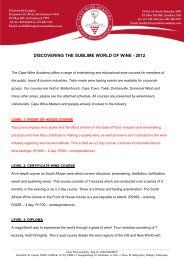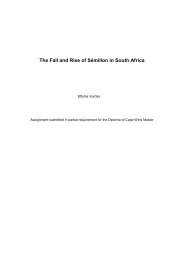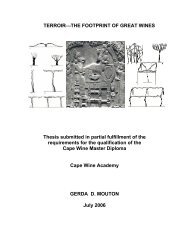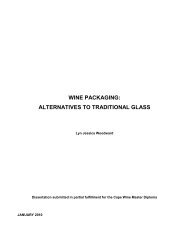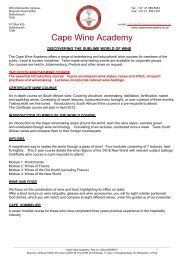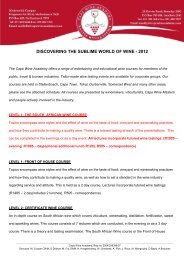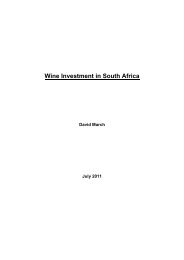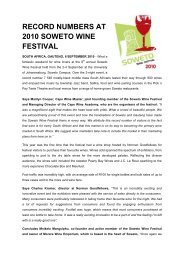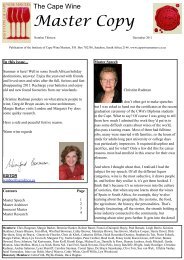Garage Winemaking in South Africa Less is More - Cape Wine ...
Garage Winemaking in South Africa Less is More - Cape Wine ...
Garage Winemaking in South Africa Less is More - Cape Wine ...
You also want an ePaper? Increase the reach of your titles
YUMPU automatically turns print PDFs into web optimized ePapers that Google loves.
patterns, determ<strong>in</strong>e how much and <strong>in</strong> what ratios compounds are synthesized <strong>in</strong><br />
trees. 63<br />
Barrels for w<strong>in</strong>e come ma<strong>in</strong>ly from France, America and Eastern Europe. French<br />
oak carries the highest reputation and price tag. French oak conta<strong>in</strong>s more<br />
extractables, polyphenols and tann<strong>in</strong>s than American oak. American oak has a<br />
relatively low phenol count and a high concentration of aromatic substances <strong>in</strong><br />
compar<strong>is</strong>on to French oak species. American tends to give a less subtle, more<br />
pungent coconut, spicy and vanilla flavour. Prices of American oak are almost half<br />
the price of French, probably due to the fact that it <strong>is</strong> so dense that it rema<strong>in</strong>s<br />
watertight even after saw<strong>in</strong>g. French oak needs to be split. Due to its obvious<br />
flavours, American Oak <strong>is</strong> used for powerfully flavoured red w<strong>in</strong>es. 64<br />
The size of the barrel as well as the age of the barrel <strong>is</strong> fundamental. The smaller<br />
the barrel the higher the ratio of surface area to volume and the more impact the<br />
wood <strong>is</strong> likely to have on the w<strong>in</strong>e <strong>in</strong> either physical or flavour sense. The newer the<br />
barrel, the more oak flavour and tann<strong>in</strong> it has to be leeched <strong>in</strong>to the w<strong>in</strong>e. After 3 or<br />
4 years there <strong>is</strong> little left to impart flavour and the wood <strong>is</strong> merely a storage<br />
conta<strong>in</strong>er.<br />
Season<strong>in</strong>g and toast<strong>in</strong>g also affect the flavour the barrel imparts. Trees are<br />
dried either naturally or artificially. The wood can be seasoned naturally by be<strong>in</strong>g left<br />
outside for two to three years where it <strong>is</strong> exposed to the elements. Th<strong>is</strong> allows the<br />
wood to dry naturally while the ra<strong>in</strong> gradually leaches out all the hard green tann<strong>in</strong>s<br />
from the oak. Wood <strong>is</strong> artificially seasoned by keep<strong>in</strong>g the oak staves <strong>in</strong> a ventilated<br />
dry<strong>in</strong>g oven at 40-60ºC for about a month. Natural season<strong>in</strong>g <strong>is</strong> a far superior<br />
process due to years <strong>in</strong> the w<strong>in</strong>d and ra<strong>in</strong> wash<strong>in</strong>g out the harsh tann<strong>in</strong>s and other<br />
unpleasant components. Dur<strong>in</strong>g th<strong>is</strong> drawn out natural season<strong>in</strong>g time the physical,<br />
aromatic and organoleptic qualities of oak for use <strong>in</strong> w<strong>in</strong>e production improve. The<br />
oven dry<strong>in</strong>g process does not allow for the same amount of leach<strong>in</strong>g to take place <strong>in</strong><br />
the wood. 65<br />
Along with season<strong>in</strong>g, the toast<strong>in</strong>g of the barrel <strong>is</strong> a very important part of barrelmak<strong>in</strong>g.<br />
Not only does it set the barrel <strong>in</strong> its f<strong>in</strong>al shape, but the heat applied to the<br />
wood leads to the formation of aromatic compounds which are important <strong>in</strong> the<br />
maturation of w<strong>in</strong>e. The heat source for toast<strong>in</strong>g <strong>is</strong> ideally an open fire fuelled by oak<br />
but can be gas or electricity. There are generally three levels of toast<strong>in</strong>g, light,<br />
medium and heavy. One cooper‟s medium toast might not be like another‟s, so<br />
w<strong>in</strong>emakers need to select their wood carefully and build relationships with<br />
cooperages that produce a level of toast<strong>in</strong>g that works with their specific w<strong>in</strong>e style. 66<br />
There are lots of alternative wood products on the market today, but the<br />
conclusion still <strong>is</strong> that barrels reign supreme. The problem with most staves/chips <strong>is</strong><br />
they are made from <strong>in</strong>ferior wood to beg<strong>in</strong> with. The other problem <strong>is</strong> that by putt<strong>in</strong>g<br />
the wood alternative <strong>in</strong> a tank, your w<strong>in</strong>e <strong>is</strong> m<strong>is</strong>s<strong>in</strong>g out on the importance of micro<br />
32



